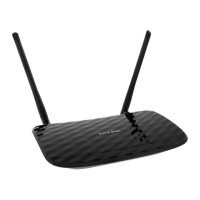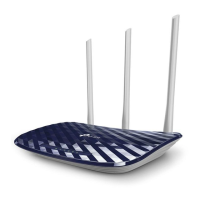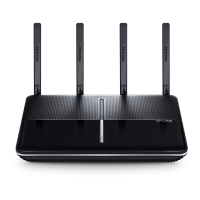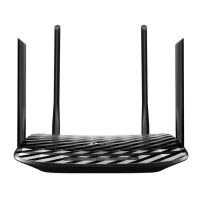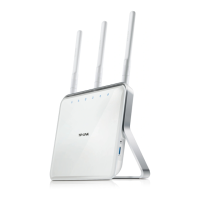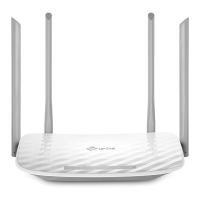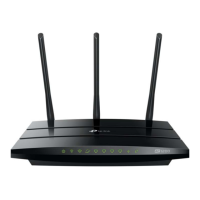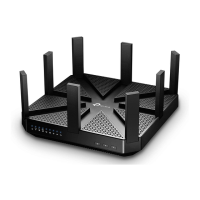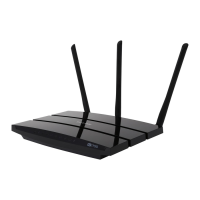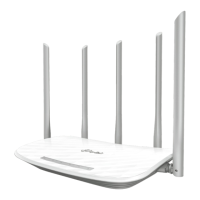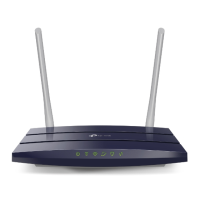Do you have a question about the TP-Link Archer C2300 and is the answer not in the manual?
Details the features and design of the TP-Link router for SOHO networks.
Describes the front, side, and back panels of the router, including LEDs.
Provides guidance on optimal placement of the router for performance and safety.
Step-by-step instructions for connecting the router to the modem and power.
Guides users through an automated process for setting up the router's internet connection.
Instructions for configuring internet connection settings manually based on ISP information.
Details on configuring the router for IPv6 internet service provided by the ISP.
Instructions on creating a TP-Link ID for cloud management and remote access.
Steps to modify the email address and password associated with a TP-Link ID.
How to add, remove, and manage user TP-Link IDs for router access.
Guide to using the TP-Link Tether mobile app for router management.
Steps to set up a separate Wi-Fi network for guests, enhancing security.
Options for configuring guest network isolation and access permissions.
Instructions on accessing files stored on USB devices connected to the router.
How to share media files from USB storage via DLNA-supported devices.
Guide to sharing a connected USB printer across the network.
Setup for using Time Machine backups on Mac computers with router-connected USB storage.
Features for managing internet access and content for family members.
Prioritizes internet traffic for applications or devices to ensure smooth performance.
Built-in antivirus features to protect the network from malware and threats.
Configuring firewall and DoS Protection to prevent cyber threats.
Blocking or allowing specific devices to access the network via MAC address.
Binding IP addresses to MAC addresses to prevent ARP spoofing attacks.
Configuring virtual servers to make local network services accessible online.
Dynamically opening ports for applications like online games and VoIP.
Setting up a DMZ host for unlimited bidirectional communication with applications.
Enabling UPnP for seamless online gaming and real-time communication.
Setting up an OpenVPN server for secure remote access to the home network.
Configuring a PPTP VPN server for remote access, offering ease of use.
Modifying the router's default LAN IP address and subnet mask.
Combining multiple ports to create a single high-bandwidth data path.
Setting up the router for IPTV services, including IGMP proxy configuration.
Configuring DHCP server settings, including IP address pool and reservations.
Configuring DDNS to access the router remotely using a domain name.
Manually configuring routing tables for specific network destinations.
Customizing wireless network name (SSID), password, security, and other parameters.
Utilizing WPS for quick and secure wireless device connection to the network.
Setting a schedule to automatically turn wireless networks on or off.
Configuring the router's system time from the internet, PC, or manually.
Turning router LEDs on or off, including a night mode feature.
Using diagnostic tools like Ping and Traceroute to test network connectivity.
Configuring port mirroring to forward traffic copies for network monitoring.
Procedures for upgrading the router's firmware online or locally.
Saving and restoring router configuration settings, and factory reset options.
Changing the login password for the router's web management page.
Configuring and using the password recovery feature for the router login.
Limiting router access based on MAC addresses for LAN connected devices.
Configuring settings for managing the router remotely over the internet.
Saving and sending system logs for troubleshooting router issues.
Details the features and design of the TP-Link router for SOHO networks.
Describes the front, side, and back panels of the router, including LEDs.
Provides guidance on optimal placement of the router for performance and safety.
Step-by-step instructions for connecting the router to the modem and power.
Guides users through an automated process for setting up the router's internet connection.
Instructions for configuring internet connection settings manually based on ISP information.
Details on configuring the router for IPv6 internet service provided by the ISP.
Instructions on creating a TP-Link ID for cloud management and remote access.
Steps to modify the email address and password associated with a TP-Link ID.
How to add, remove, and manage user TP-Link IDs for router access.
Guide to using the TP-Link Tether mobile app for router management.
Steps to set up a separate Wi-Fi network for guests, enhancing security.
Options for configuring guest network isolation and access permissions.
Instructions on accessing files stored on USB devices connected to the router.
How to share media files from USB storage via DLNA-supported devices.
Guide to sharing a connected USB printer across the network.
Setup for using Time Machine backups on Mac computers with router-connected USB storage.
Features for managing internet access and content for family members.
Prioritizes internet traffic for applications or devices to ensure smooth performance.
Built-in antivirus features to protect the network from malware and threats.
Configuring firewall and DoS Protection to prevent cyber threats.
Blocking or allowing specific devices to access the network via MAC address.
Binding IP addresses to MAC addresses to prevent ARP spoofing attacks.
Configuring virtual servers to make local network services accessible online.
Dynamically opening ports for applications like online games and VoIP.
Setting up a DMZ host for unlimited bidirectional communication with applications.
Enabling UPnP for seamless online gaming and real-time communication.
Setting up an OpenVPN server for secure remote access to the home network.
Configuring a PPTP VPN server for remote access, offering ease of use.
Modifying the router's default LAN IP address and subnet mask.
Combining multiple ports to create a single high-bandwidth data path.
Setting up the router for IPTV services, including IGMP proxy configuration.
Configuring DHCP server settings, including IP address pool and reservations.
Configuring DDNS to access the router remotely using a domain name.
Manually configuring routing tables for specific network destinations.
Customizing wireless network name (SSID), password, security, and other parameters.
Utilizing WPS for quick and secure wireless device connection to the network.
Setting a schedule to automatically turn wireless networks on or off.
Configuring the router's system time from the internet, PC, or manually.
Turning router LEDs on or off, including a night mode feature.
Using diagnostic tools like Ping and Traceroute to test network connectivity.
Configuring port mirroring to forward traffic copies for network monitoring.
Procedures for upgrading the router's firmware online or locally.
Saving and restoring router configuration settings, and factory reset options.
Changing the login password for the router's web management page.
Configuring and using the password recovery feature for the router login.
Limiting router access based on MAC addresses for LAN connected devices.
Configuring settings for managing the router remotely over the internet.
Saving and sending system logs for troubleshooting router issues.
| Color | black |
|---|---|
| Wi-Fi Speed | 2300 gigabits per second |
| Band Technology | dual |
| Frequency Band | 2.4 ghz, 5.0 ghz |
| Ethernet Standard | 10/100/1000 |
| Ethernet Switch | yes |
| Wireless Networking Standard | wi-fi 5 |
| Wireless Standard | ac, n |
| 2.4 Ghz Streams | 1 |
| 5.0 Ghz Streams | 1 |
| Gigabit Ethernet Speed | yes |
| Antennas | 3 |
| Parental Control | yes |
| Firewall | spi |
| Data Encryption | yes |
| Encryption Type | wep, wpa-psk, wpa2-psk |
| Ports | rj-45, usb |
| WAN Ports | 1 |
| Built In Modem | no |
| Bluetooth | no |
| Smart Applications | yes |
| System Requirements | unix, apple macos, novell netware, linux, microsoft windows nt, microsoft windows 98 segunda edición / windows 2000 |
| Height | 1.5 inches |
|---|---|
| Width | 8.5 inches |
| Net Weight | 1.35 pounds |
